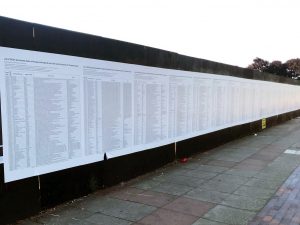In the wake of Brexit and the focus on curbing the migration of the current UK cabinet, the work of the Istanbul-based artist Banu Cennetoğlu was one of the most pointful pieces produced for the 2018 edition of the Liverpool Biennial, which opened on 14 July.
Since 2007, Cennetoğlu has been producing public displays of the list compiled each year by UNITED for Intercultural Action, which traces information relating to the deaths of refugees and migrants who have lost their lives within, or on the borders of Europe because of state policies and their supporters. The List has been successfully displayed in various public spaces in cities across Bulgaria, Germany, Greece, Italy, Switzerland, Turkey, the United States.
The project featuring names of 34,361 refugees and migrants who lost their lives trying to reach Europe, commissioned jointly by the Liverpool Biennial and London’s Chisenhale Gallery, has been installed on a 280-meter hoarding on Great George Street, where it remained until it was first removed by unknown perpetrators on 28 July. At the time, Liverpool Biennial’s Director, Sally Tallant, commented: “It is timely and important to make the List public during a global refugee crisis. We were dismayed to see it had been removed … and would like to know why. The List has been met with critical acclaim and we are doing everything we can to reinstate it.”
After being reinstalled few days later, the work was vandalized for the second time on 15 August. After the incident, the artist and Liverpool Biennial jointly declared that they will not install The List a third time, stating that the torn remnants of the display will serve as a “reminder of this systematic violence exercised against people.”
While the perpetrators and their reasons are still unknown, the repeated act of vandalism firmly implies that this was a politically-motivated attack linked the with anti-immigration rhetoric of the UK’s far-right.



